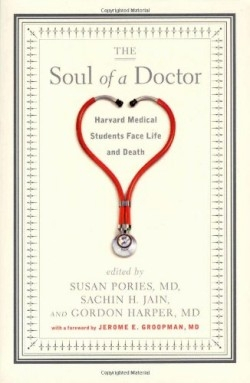The Soul of a Doctor
Harvard Medical Students Face Life and Death
A grief-stricken mother wants her picture taken with the still body of her six-month-old child. The medical student hoped the woman would change her mind or be dissuaded by the attending physician, so “she would remember her child in life and not in death.” In her vignette, “Imagine How You’d Feel,” Andrea Dalve-Endres ponders how long the doctors should try to resuscitate, whether the parents should be in the hospital room, and what to do when it’s over.
The loss of such a young soul weighs heavily on all the witnesses. One theme of this small but weighty book: losses form parts of the souls of doctors. These idealistic young writers show how patients and doctors touch one another—a far cry from the authoritarian medicine of the past. A student marvels at the power of being connected responsibly with strangers at a turning point in their lives. The oxymoron “instant intimacy” becomes real. Another argues that the value of listening to patients is not just ethically self-evident, but also cost-effective.
A concise treasury of four dozen stories, two poems, and a couple of essays by mentors, this book engages the senses and emotions as much as the intellect, through the sights, sounds, smells, and palpables of life and death on clinical wards, in surgeries, at autopsies, and with cadavers. The editors, a breast cancer surgeon and researcher (Pories), a third-year student (Jain), and a psychiatrist and teacher (Harper), divided the book into sections: “Communication;” “Empathy;” “Easing Suffering and Loss;” and “Finding a Better Way.” Students are identified in an appendix. An epilogue points out that everything is studied in medical school except the development of the physician. These essays provide an antidote, or inoculation, for that.
This is not the first book on humanizing the process of medical education; William Osler and Francis Peabody are mentioned as pioneers in that regard. The book unfortunately lacks a bibliographic summary, which would point to sociological and anthropological studies, to George Engle (biopsychosocial model), Michael Balint (doctor-patient relationship), and especially Kathryn Montgomery Hunter’s Doctors’ Stories: The Narrative Structure of Medical Knowledge (1991) in which she writes, “Understanding medicine as a narrative activity enables us—both physicians and patients—to shift the focus of medicine to the care of what ails the patient and away from the relatively simpler matter of the diagnosis of disease.”
This constructive shift of focus is the genius of this book, in which confessions of failure show how sensitive students turn painful regrets to good account. One who failed to hold a suffering patient’s hand won’t make that mistake again. Another will protest next time if a patient’s wish to forgo treatment is not honored. Others deplore the haste imposed on everyone when more time would be the best medicine, and the hazing or put-downs of those in training by their superiors (“pimping” in medical jargon).
Joe Wright, who has read some of his stories on National Public Radio, tells how he saw himself on videotape: “I exuded a brusque sort of competence, but not kindness. It seemed to me that in a couple of months I had gone from Mr. Empathy to Dr. Jerk.” Alejandra Casillas apologizes to Ms. D., who suffered painful attempts to find a vein despite her specific wishes not to have invasive procedures: “…that determined nature to help is our weakness as well. By the time we wake up from our miracle-mission coma, three needle sticks later, a helpless old woman is at her deathbed, wailing for mercy.”
Kimberly Layne Collins, in “Donor,” a paean to the occupant of a dissection table, writes, “You, our teacher, our first patient, / Would not complain through our probing / Or criticize when we cut too deep,” ending eight beautiful stanzas later at the brain: “the center of your thoughts, without knowing / which ones still lingered.”
This book is refreshing in a culture where death is either sensationalized or avoided. The soul and will of a student doctor mature through total immersion in others’ lives and deaths. Vignettes of change illustrate the life stories of ordinary people who become teachers. These luminous private experiences will touch the reader with insights, empathy, exhilaration, and humility.
Reviewed by
E. James Lieberman
Disclosure: This article is not an endorsement, but a review. The publisher of this book provided free copies of the book to have their book reviewed by a professional reviewer. No fee was paid by the publisher for this review. Foreword Reviews only recommends books that we love. Foreword Magazine, Inc. is disclosing this in accordance with the Federal Trade Commission’s 16 CFR, Part 255.

